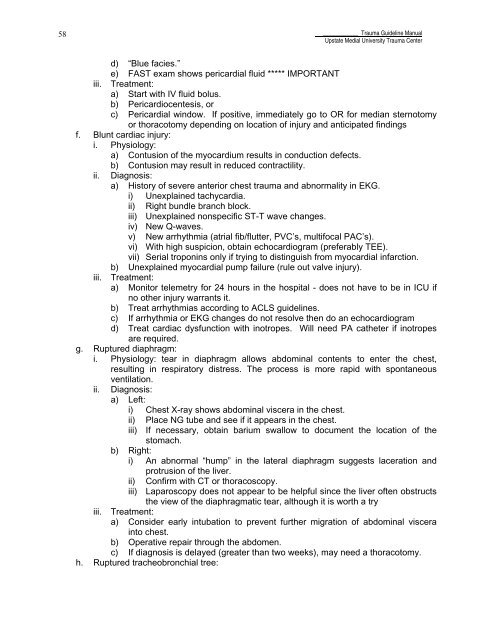Trauma Guideline Manual - SUNY Upstate Medical University
Trauma Guideline Manual - SUNY Upstate Medical University
Trauma Guideline Manual - SUNY Upstate Medical University
Create successful ePaper yourself
Turn your PDF publications into a flip-book with our unique Google optimized e-Paper software.
58____________ <strong>Trauma</strong> <strong>Guideline</strong> <strong>Manual</strong><strong>Upstate</strong> Medial <strong>University</strong> <strong>Trauma</strong> Centerd) “Blue facies.”e) FAST exam shows pericardial fluid ***** IMPORTANTiii. Treatment:a) Start with IV fluid bolus.b) Pericardiocentesis, orc) Pericardial window. If positive, immediately go to OR for median sternotomyor thoracotomy depending on location of injury and anticipated findingsf. Blunt cardiac injury:i. Physiology:a) Contusion of the myocardium results in conduction defects.b) Contusion may result in reduced contractility.ii. Diagnosis:a) History of severe anterior chest trauma and abnormality in EKG.i) Unexplained tachycardia.ii) Right bundle branch block.iii) Unexplained nonspecific ST-T wave changes.iv) New Q-waves.v) New arrhythmia (atrial fib/flutter, PVC’s, multifocal PAC’s).vi) With high suspicion, obtain echocardiogram (preferably TEE).vii) Serial troponins only if trying to distinguish from myocardial infarction.b) Unexplained myocardial pump failure (rule out valve injury).iii. Treatment:a) Monitor telemetry for 24 hours in the hospital - does not have to be in ICU ifno other injury warrants it.b) Treat arrhythmias according to ACLS guidelines.c) If arrhythmia or EKG changes do not resolve then do an echocardiogramd) Treat cardiac dysfunction with inotropes. Will need PA catheter if inotropesare required.g. Ruptured diaphragm:i. Physiology: tear in diaphragm allows abdominal contents to enter the chest,resulting in respiratory distress. The process is more rapid with spontaneousventilation.ii. Diagnosis:a) Left:i) Chest X-ray shows abdominal viscera in the chest.ii) Place NG tube and see if it appears in the chest.iii) If necessary, obtain barium swallow to document the location of thestomach.b) Right:i) An abnormal “hump” in the lateral diaphragm suggests laceration andprotrusion of the liver.ii) Confirm with CT or thoracoscopy.iii) Laparoscopy does not appear to be helpful since the liver often obstructsthe view of the diaphragmatic tear, although it is worth a tryiii. Treatment:a) Consider early intubation to prevent further migration of abdominal viscerainto chest.b) Operative repair through the abdomen.c) If diagnosis is delayed (greater than two weeks), may need a thoracotomy.h. Ruptured tracheobronchial tree:
















